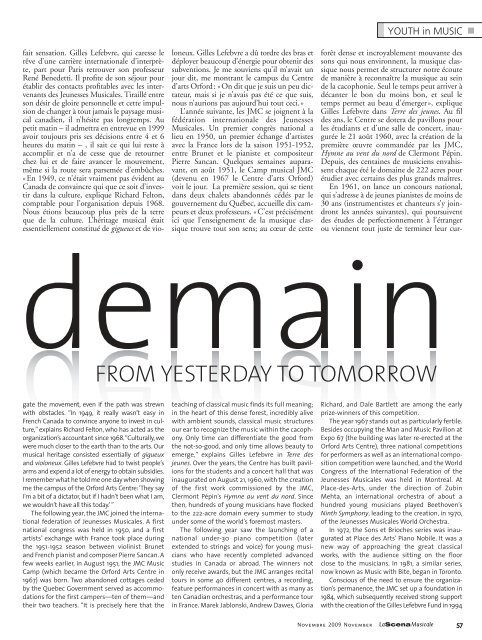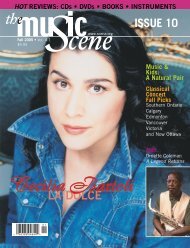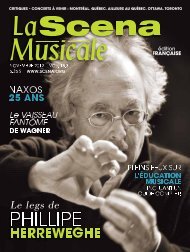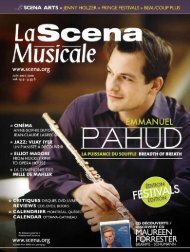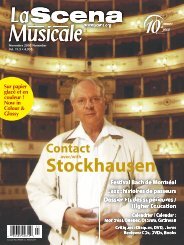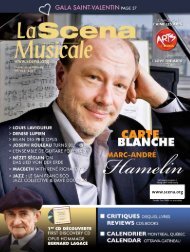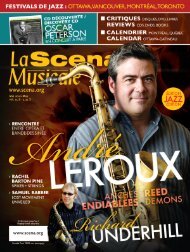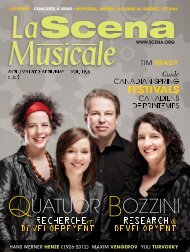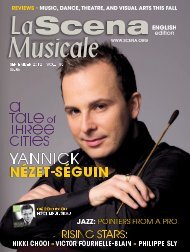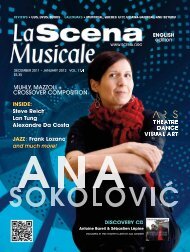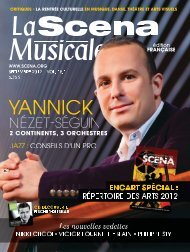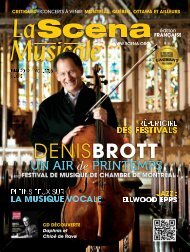Create successful ePaper yourself
Turn your PDF publications into a flip-book with our unique Google optimized e-Paper software.
fait sensation. Gilles Lefebvre, qui caresse le<br />
rêve d’une carrière internationale d’interprète,<br />
part pour Paris retrouver son professeur<br />
René Benedetti. Il profite de son séjour pour<br />
établir des contacts profitables avec les intervenants<br />
des Jeunesses <strong>Musicale</strong>s. Tiraillé entre<br />
son désir de gloire personnelle et cette impulsion<br />
de changer à tout jamais le paysage musical<br />
canadien, il n’hésite pas longtemps. Au<br />
petit matin – il admettra en entrevue en 1999<br />
avoir toujours pris ses décisions entre 4 et 6<br />
heures du matin – , il sait ce qui lui reste à<br />
accomplir et n’a de cesse que de retourner<br />
chez lui et de faire avancer le mouvement,<br />
même si la route sera parsemée d’embûches.<br />
«En 1949, ce n’était vraiment pas évident au<br />
Canada de convaincre qui que ce soit d’investir<br />
dans la culture, explique Richard Felton,<br />
comptable pour l’organisation depuis 1968.<br />
Nous étions beaucoup plus près de la terre<br />
que de la culture. L’héritage musical était<br />
essentiellement constitué de gigueux et de violoneux.<br />
Gilles Lefebvre a dû tordre des bras et<br />
déployer beaucoup d’énergie pour obtenir des<br />
subventions. Je me souviens qu’il m’avait un<br />
jour dit, me montrant le campus du Centre<br />
d’arts Orford: «On dit que je suis un peu dictateur,<br />
mais si je n’avais pas été ce que suis,<br />
nous n’aurions pas aujourd’hui tout ceci.»<br />
L’année suivante, les JMC se joignent à la<br />
fédération internationale des Jeunesses<br />
<strong>Musicale</strong>s. Un premier congrès national a<br />
lieu en 1950, un premier échange d’artistes<br />
avec la France lors de la saison 1951-1952,<br />
entre Brunet et le pianiste et compositeur<br />
Pierre Sancan. Quelques semaines auparavant,<br />
en août 1951, le Camp musical JMC<br />
(devenu en 1967 le Centre d’arts Orford)<br />
voit le jour. <strong>La</strong> première session, qui se tient<br />
dans deux chalets abandonnés cédés par le<br />
gouvernement du Québec, accueille dix campeurs<br />
et deux professeurs. « C’est précisément<br />
ici que l’enseignement de la musique classique<br />
trouve tout son sens; au cœur de cette<br />
YOUTH in MUSIC<br />
demain<br />
FROM YESTERDAY TO TOMORROW<br />
forêt dense et incroyablement mouvante des<br />
sons qui nous environnent, la musique classique<br />
nous permet de structurer notre écoute<br />
de manière à reconnaître la musique au sein<br />
de la cacophonie. Seul le temps peut arriver à<br />
décanter le bon du moins bon, et seul le<br />
temps permet au beau d’émerger », explique<br />
Gilles Lefebvre dans Terre des jeunes. Au fil<br />
des ans, le Centre se dotera de pavillons pour<br />
les étudiants et d’une salle de concert, inaugurée<br />
le 21 août 1960, avec la création de la<br />
première œuvre commandée par les JMC,<br />
Hymne au vent du nord de Clermont Pépin.<br />
Depuis, des centaines de musiciens envahissent<br />
chaque été le domaine de 222 acres pour<br />
étudier avec certains des plus grands maîtres.<br />
En 1961, on lance un concours national,<br />
qui s’adresse à de jeunes pianistes de moins de<br />
30 ans (instrumentistes et chanteurs s’y joindront<br />
les années suivantes), qui poursuivent<br />
des études de perfectionnement à l’étranger<br />
ou viennent tout juste de terminer leur curgate<br />
the movement, even if the path was strewn<br />
with obstacles. “In 1949, it really wasn’t easy in<br />
French Canada to convince anyone to invest in culture,”<br />
explains Richard Felton, who has acted as the<br />
organization’s accountant since 1968.“Culturally, we<br />
were much closer to the earth than to the arts. Our<br />
musical heritage consisted essentially of gigueux<br />
and violoneux. Gilles Lefebvre had to twist people’s<br />
arms and expend a lot of energy to obtain subsidies.<br />
I remember what he told me one day when showing<br />
me the campus of the Orford Arts Centre: ‘They say<br />
I’m a bit of a dictator, but if I hadn’t been what I am,<br />
we wouldn’t have all this today.’ ”<br />
The following year, the JMC joined the international<br />
federation of Jeunesses <strong>Musicale</strong>s. A first<br />
national congress was held in 1950, and a first<br />
artists’ exchange with France took place during<br />
the 1951-1952 season between violinist Brunet<br />
and French pianist and composer Pierre Sancan. A<br />
few weeks earlier, in August 1951, the JMC Music<br />
Camp (which became the Orford Arts Centre in<br />
1967) was born. Two abandoned cottages ceded<br />
by the Quebec Government served as accommodations<br />
for the first campers—ten of them—and<br />
their two teachers. “It is precisely here that the<br />
teaching of classical music finds its full meaning;<br />
in the heart of this dense forest, incredibly alive<br />
with ambient sounds, classical music structures<br />
our ear to recognize the music within the cacophony.<br />
Only time can differentiate the good from<br />
the not-so-good, and only time allows beauty to<br />
emerge,” explains Gilles Lefebvre in Terre des<br />
jeunes. Over the years, the Centre has built pavilions<br />
for the students and a concert hall that was<br />
inaugurated on August 21, 1960, with the creation<br />
of the first work commissioned by the JMC,<br />
Clermont Pépin’s Hymne au vent du nord. Since<br />
then, hundreds of young musicians have flocked<br />
to the 222-acre domain every summer to study<br />
under some of the world’s foremost masters.<br />
The following year saw the launching of a<br />
national under-30 piano competition (later<br />
extended to strings and voice) for young musicians<br />
who have recently completed advanced<br />
studies in Canada or abroad. The winners not<br />
only receive awards, but the JMC arranges recital<br />
tours in some 40 different centres, a recording,<br />
feature performances in concert with as many as<br />
ten Canadian orchestras, and a performance tour<br />
in France. Marek Jablonski, Andrew Dawes, Gloria<br />
Richard, and Dale Bartlett are among the early<br />
prize-winners of this competition.<br />
The year 1967 stands out as particularly fertile.<br />
Besides occupying the Man and Music Pavilion at<br />
Expo 67 (the building was later re-erected at the<br />
Orford Arts Centre), three national competitions<br />
for performers as well as an international composition<br />
competition were launched, and the World<br />
Congress of the International Federation of the<br />
Jeunesses <strong>Musicale</strong>s was held in Montreal. At<br />
Place-des-Arts, under the direction of Zubin<br />
Mehta, an international orchestra of about a<br />
hundred young musicians played Beethoven’s<br />
Ninth Symphony, leading to the creation, in 1970,<br />
of the Jeunesses <strong>Musicale</strong>s World Orchestra.<br />
In 1972, the Sons et Brioches series was inaugurated<br />
at Place des Arts’ Piano Nobile. It was a<br />
new way of approaching the great classical<br />
works, with the audience sitting on the floor<br />
close to the musicians. In 1981, a similar series,<br />
now known as Music with Bite, began in Toronto.<br />
Conscious of the need to ensure the organization’s<br />
permanence, the JMC set up a foundation in<br />
1984, which subsequently received strong support<br />
with the creation of the Gilles Lefebvre Fund in 1994<br />
Novembre 2009 November 57


